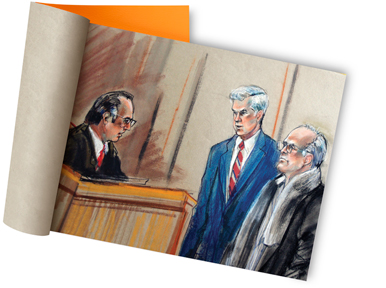
Even among an elite subset of artists, Marilyn Church stands out. A courtroom illustrator for 43 years, she's the only one in her shrinking field who uses water soluble crayons. (Her "eraser" of choice? A wet Bounty paper towel-"the only brand that works," says the New Yorker.)
Church has documented some of the most high-profile cases of the late
twentieth century using charcoal pencils, colored pencils, and Swiss
Caran d'Ache crayons, which are denser than the wax variety and soft
enough to smudge with a fingertip. "I can make the crayons dissolve so
it looks like a wash," she says, "and once it's dry it doesn't smear."
From her perch in the front row, reserved for illustrators and reporters, Church has anywhere from 20 minutes, in the case of a sentencing or arraignment, to five hours to sketch a composite of the scene. "A drawing is going to tell more of the story than any photograph can-and it's going to be aesthetically beautiful, too," she says.
Her illustrations of Martha Stewart, "blind sheikh" Omar Abdel-Rahman, and the Central Park jogger defendants have been splashed across the pages of the New York Times and featured on CNN and ABC. Now, 23 of them are showcased in the Library of Congress's new exhibit, Drawing Justice: The Art of Courtroom Illustration.
In 2010 the library acquired more than 4,500 of Church's illustrations, including sketches of mob boss John Gotti. During his 1992 murder trial, the "Dapper Don" caught her sharp blue eyes, pointed to his neck, and wagged his finger. "He was unhappy with the way I depicted his fat neck," Church laughs.
"This job is an adrenaline rush. You're witness to the best legal minds, the most intriguing dramas-but you have to have a thick skin."